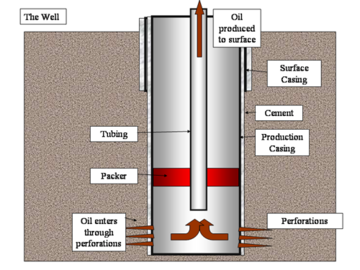An oil well is a term for any drilling or boring through the Earth's surface designed to find and release both petroleum oil and gas hydrocarbons.
Synopsis[]
The well is created by drilling a hole of about (100 to 800 mm dia) into the earth with an oil rig turning a drill bit. After the hole is drilled, a metal pipe called a 'casing' is cemented into the hole. In order to gain access to the "hydrocarbon producing interval", the casing and cement are either perforated ('cased hole completion') or an additional section of earth is drilled below the casing ('open hole completion'). In most cases, several casings are set into the well, starting with a large shallow casing, and then deeper casings are set into smaller holes drilled through the upper casings.
To drill the well,
- the drill bit, breaks up the earth (which is then washed out of the hole with the 'drilling mud') and extends the well;
- the pipe or drill string to which the bit is attached is gradually lengthened as the well gets deeper;
- the oil rig which fulfills the role of superstructure bearing the load of the drill string and also contains machinery to rotate or percuss the drill string.
The earliest oil wells were drilled percussively (cable-tool drilling), that is, holes were drilled simply by hammering at the earth. Very soon, the limited depths which this method could attain meant that rotary drilling was introduced. Modern wells drilled using rotary drills can achieve lengths of over 12,000 meters / 38,000 feet.
Until the 1970s, most oil wells were vertical (or, more specifically, were supposed to be vertical — deviations introduced by different lithology and mechanical imperfections meant that most wells were at least slightly deviated). However, modern technologies allow strongly deviated wells which can, given sufficient depth, actually become horizontal. This is of great value as the reservoir rocks which contain hydrocarbons are usually horizontal, or sub-horizontal. A well, therefore, which passes along a reservoir (rather than through it, as a vertical well must) can tap a larger volume with a much larger surface area (and thus a correspondingly higher production rate). Using deviated and horizontal drilling, it has also become possible to reach reservoirs several kilometers away from the drilling place (Extended Reach Drilling), allowing to produce hydrocarbons from underneath e.g. environmentally sensitive areas or offshore close to the coast line.
After drilling and casing the well, it must be 'completed'. Completion is the process in which the well in enabled to produce oil or gas. In a cased-hole completion, holes (called perforations) must be made in the casing to provide a path for the oil to flow from the reservoir into the well bore. In open hole completion, often 'sand-screens' or a 'gravel pack' is installed in the uncased reservoir section to prevent incompetent rock formations from falling into the hole and blocking it off. Next, sometimes acids or other fluids are pumped into the well to fracture the rock to provide a flow path deep into the formation for oil to flow along into the well bore. Alternatively, the acid could be used just to clean the rock face of remanents of the drilling fluid which could impede oil flow. Finally, 'tubing' (smaller diameter pipe, from 50 to 150 mm diameter) is typically run into the well and packed off at the base, inside the casing. The well produces up through the tubing. This arrangement provides a redundant barrier to leaks of hydrocarbons as well as allowing damaged sections to be replaced.
Oil wells can be characterized as
- production wells when they are drilled primarily for producing oil or gas, once the producing structure and characteristics are established
- appraisal wells when they are used to assess characteristics (such as flowrate) of a proven hydrocarbon accumulation
- exploration wells when they are drilled purely for exploratory (information gathering) purposes in a new area
- wildcat wells when a well is drilled, based on a large element of hope, in a frontier area where very little is known about the subsurface. In the early days of oil exploration in Texas, wildcats were common as productive areas were not yet established. In modern times, oil exploration in many areas have reached a very mature phase and the chances of finding oil simply by drilling at random are very low. Therefore, a lot more effort is placed in exploration and appraisal wells.
Lahee classification [1]
- New Field Wildcat (NFW)—far from other producing fields and on a structure that has not previously produced.
- New Pool Wildcat (NPW)—new pools on already producing structure.
- Deeper Pool Test (DPT)-on already producing structure and pool, but on a deeper pay zone.
- Shallower Pool Test (SPT)-on already producing structure and pool, but on a shallower pay zone.
- Outpost (OUT)—usually two or more locations from nearest productive area.
- Development Well (DEV)- can be on the extension of a pay zone, or between existing wells (Infill).
Cost[]
Modern oil wells can be extremely expensive to build and maintain, due partly to the cost of the technologies in active use today, but also to the increasingly inclement climates and harsh environments that are today being explored for oil and gas.
Onshore wells can be considerably cheaper, particular if the field is at a shallow depth.
Terrestrial[]
By far the most common type of well is of the onshore variety.
Reefs[]
Offshore platforms, the wells supporting structure, produce artificial reefs .
See also[]
- Directional drilling
- Drilling rig
- Pumpjack
- Spindletop
External links[]
| This page uses Creative Commons Licensed content from Wikipedia (view authors). | 
|
